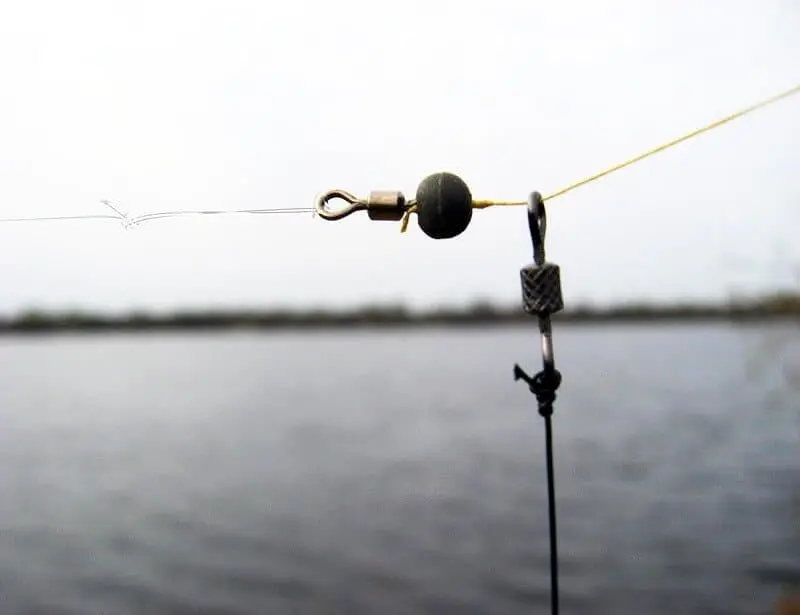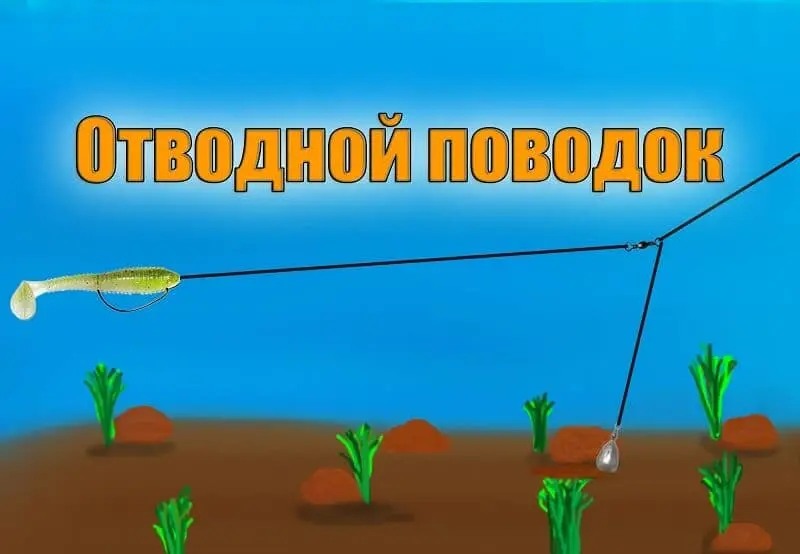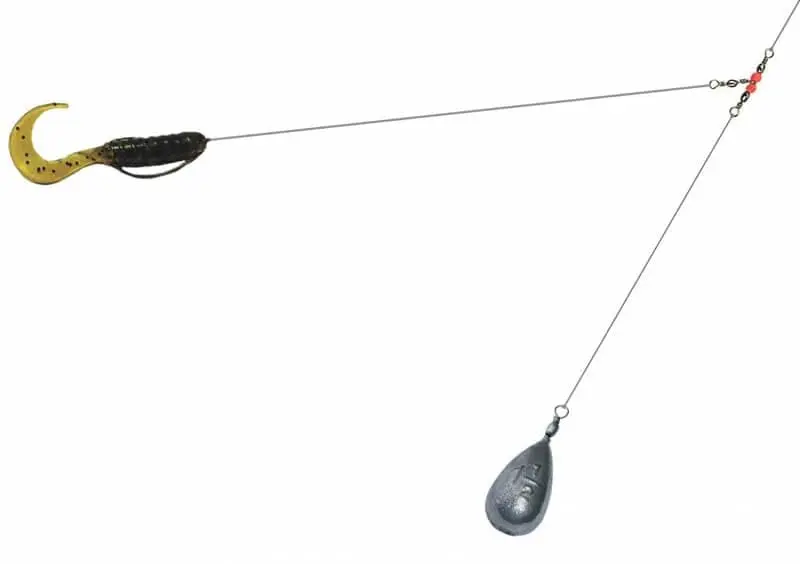Contents
Fishing on a leash is not a classic, although it is used by anglers quite often. This type of equipment is also called Moscow, the main difference from other types of spinning fishing will be that the bait itself and the load are in different thicknesses, that is, they are simply spaced apart. The most commonly used leash for perch, pike, pike perch in the course and in still water.
Tackle components
Spinning with a jig brings good results, but, as practice shows, fishing with a retractable leash works many times more productive. It is not difficult to assemble tackle, the main thing is to know all the components of the tackle, to choose them correctly.
To collect tackle you need to have:
- Properly selected rod and reel.
- Suitable thickness braided line or good quality monofilament line.
- Lead material or lead line.
- Quality hooks.
- Baits, silicone or other type.
- Fittings.
- Sinkers with an eye or a swivel 15-30 g depending on the chosen place of fishing.
This is followed by work on the collection of installation, but first we will dwell on a more detailed description of each component.

Rod
The form for this type of fishing is used taking into account where fishing is planned from:
- For casting from a boat, you need a shorter twig, 1,8-2 m is enough.
- Fishing from the coastline provides for longer blanks, choose from options of 2,1-2,4 m.
When choosing a rod, pay attention to the quality of the inserts in the rings, SIC ceramics and a titanium insert are considered an excellent option.
Coil
A spinning reel is suitable for rigging a rod, which is selected depending on the length of the rod and test indicators. You should not put heavy versions of “meat grinders” with a baitrunner or multipliers, an ordinary spinning one will do just fine. The main characteristics are easy running, the presence of a bearing in the line guide and the ability to withstand medium loads.
Main line and leader line
For catching perch and other types of predator, it is better to use a braided line as the main one. Due to the smaller thickness and greater discontinuity, the windage is reduced, which allows you to hook and bring out even large individuals without any problems.
Depending on the test indicators and the purposefulness of fishing, cords with a thickness of 0,12-0,16 mm are used. At the same time, it is advisable to feel the goods before buying, most manufacturers often overestimate the thickness indicators.
When buying a cord for spinning, pay attention to the number of veins. It is better to give preference to options from 8 weaves.
The choice of leash material is also important, depending on who is being hunted in the pond, different leash options are used:
- For perch fishing, high-quality fishing line 0,16-0,2 mm is suitable, it is better to give preference to fluorocarbon or good quality monofilament.
- It’s better not to catch pike perch on fluorocarbon, for this predator you need stronger materials. An excellent option would be a leash made of tungsten or a quality monk.
- Catching a pike with such tackle will go off without a hitch if you use steel as a leash. The string has also proven itself well, the softness and strength of the material used will be an important point.
Hooks
For silicone baits, hooks without a load are used. The quality of the hooks used must be excellent, otherwise gatherings cannot be avoided. Catching perch and pike is possible on ordinary single ones, silicone is often equipped with twins, some use a small tee in addition to a single one. In places with a lot of vegetation, offset tools are used; such a hook made of high-strength waist is also suitable for catching pike perch for this installation.
When choosing a single hook for silicone lures, it is better to give preference to options with a large ear and serifs on the back. A large ear will allow you to tie a leash without any problems, and serifs will not let the bait slip even with a strong current.
Sinkers
Several types of products are used as cargo:
- The most common is the drop shot. This option is an elongated type of sinker with a soldered swivel at one end. The weight of the product is different, it is used depending on the place of fishing.
- A drop on a swivel is used quite often too. The streamlined shape allows you to pass through the problematic bottom without hooks.
- Bullet-shaped cargo is no less popular among fishermen, at the sharper end there is a ring or swivel, which reduces the number of overlaps at times.
Some prefer sinkers with wings, but this is already an amateur.

Findings
When collecting gear, you will need such little things as swivels and fasteners. Their quality must also be at the level so that during the process of wiring when hooking or when catching a trophy specimen, these mounting elements can withstand the load.
Baits
Installation for catching perch and other predators is not possible without baits, which can be very diverse:
- Silicone baits, twisters and vibrotails are most often used. Crustaceans and worms from the edible silicone subspecies are gaining popularity. These baits work great both on the lake and on the river.
- Less commonly used are small wobblers with a small shovel and a suspender characteristic. This type of bait is used in the current.
- Small swings and turntables are not very often used by anglers, but still some use them.
The sizes of all the lures described above are relatively small, but it all depends on what size the fish lives in the chosen reservoir and who is being hunted. Small size silicone 3-5 cm prefers perch and small pike, wobblers and 5-7 cm bobcats will attract the attention of larger individuals of toothy and pike perch on the river. Large predators are happy to chase a 12 cm long worm and will definitely catch it.
The color preferences of each fish are individual:
- Installation for catching zander is equipped with medium-sized silicone and in yellow-orange tones. A good option would be any carrot-colored vibrotail with a sparkle or slightly light tummy.
- Pike and perch respond well to bright green acidfish, yellow, green lemon twisters.
We collect tackle
How to wind the main line on the reel is not worth telling, every self-respecting fisherman should be able to do this. Let’s move on to the collection of tackle with a leash, sinker and bait. Work is carried out in the following order:
- A prepared piece of leader material is tied to the bait if silicone is used on the hook. Wobbler or spinners are attached using a pre-installed fastener. The length of the leash can be different, the minimum is 50 cm, the maximum length is chosen by the angler himself, usually it is no more than 150 cm.
- A sinker is attached to the main one, depending on what type of gear is collected, it is knitted through a swivel or in other ways.
- The final step is to mount the leash just above the sinker.
The tackle is ready, you can throw it and try to hold it.
Mounting options
Mounting for pike, zander and perch can be of several varieties. Each angler chooses the one that suits him the most.
Deaf
This species is considered the simplest used for fishing on the river and lakes. Collect it yourself under the power of the angler without any experience. Assembly assembly is carried out as follows:
- The sinker on the swivel is fixed at the end of the main fishing line or cord.
- Above 20-30 cm, a leash and the bait itself are attached.
There are many ways to mount, each of which will be no less effective.
With triple swivel
To the end of the main fishing line, a triple T-shaped swivel is knitted. To the remaining ears, respectively, a sinker is knitted below on a piece of the main fishing line or cord. The side eye serves as a place for attaching the leash itself with the bait.
For such an installation, it is advisable to choose swivels with beads between the barrel and the loops. Such a product will not cut the fishing line when casting.
Sliding
This type of installation is more suitable for experienced spinners, as a novice fisherman may have problems even when casting gear. The formation goes like this:
- The leash with the bait is tightly knitted through the swivel to the main line.
- In front of the leash, on the same swivel, there is a sinker tied to a piece of fishing line or cord of the main diameter.
The leash under the load is installed no more than 30 cm, and in order to reduce the overlap of the tackle, you can install a stopper that will limit the sliding of the leash with the load along the main one.
This type of installation is convenient in that you can change the location of the load, thereby increasing or shortening the length of the leash with the bait.
Catching pike perch on such a mount involves the use of longer leashes than catching pike or perch.

How to attach a leash
There are several ways to attach a leash to the main one:
- The loop into the loop is considered the simplest, it has been used for many years, it does not require the use of additional components, which will not make the tackle itself heavier.
- Fastening through a swivel is used quite often; such an installation will allow casting tackle without overlaps.
- A swivel with a clasp is currently recognized as the most convenient for fishing. With the help of such assistants, there are no problems with replacing the leash.
Each angler should choose a convenient installation independently.
Advantages and disadvantages of installation
Fishing with a retractable leash has many advantages:
- baits are thrown at various distances;
- the wind will not be able to prevent the casting of such gear;
- the finished snap is quite sensitive;
- used a wide range of baits of different types.
But there are also disadvantages to such an installation. For some, they are not significant, and for some, they will not be able to accept them:
- to collect tackle will have to spend a certain period of time;
- wiring time is longer than other snap-ins;
- there is no possibility to control the equipment;
- increases the likelihood of hooks and false bites.
Nevertheless, this method of fishing on the lake and on the river is quite popular, and has recently gained more and more fans.
Fishing methods
The wiring of abandoned tackle for all types of fish is the same, the differences will be only in the elements used for rigging. To be with a catch, fishing with a diversion leash is carried out as follows:
- after casting the tackle, it is necessary to wait for the moment when the load falls to the bottom, this is determined by the appearance of a slack on a stretched fishing line;
- it is at this moment that they make a small winding.
These are the basic wiring rules, while the winding itself can be carried out both quickly with stops and slowly. Experienced anglers advise doing 2-4 turns with the reel, and then stopping for a couple of moments, this is quite enough to lure the fish. To attract the attention of trophy specimens during posting, you can additionally create vibration with the tip of the rod.
It is important to ensure that during the pauses the line is taut, if a bite occurs during this period, you must immediately hook it, sharply and confidently.
The bait on a retractable leash goes in the water column, and the load is at the bottom, attracting the attention of a predator and not only. There are fewer hooks with such tackle, and large areas can be caught. Therefore, in many cases, it is better to give preference to just such gear than using a jig.









